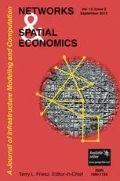Abstract
Location-allocation problems are a class of complicated optimization problems that determine the location of facilities and the allocation of customers to the facilities. In this paper, the uncapacitated continuous location-allocation problem is considered, and a particle swarm optimization approach, which has not previously been applied to this problem, is presented. Two algorithms including classical and hybrid particle swarm optimization algorithms are developed. Local optima of the problem are obtained by two local search heuristics that exist in the literature. These algorithms are combined with particle swarm optimization to construct an efficient hybrid approach. Many large-scale problems are used to measure the effectiveness and efficiency of the proposed algorithms. Our results are compared with the best algorithms in the literature. The experimental results show that the hybrid PSO produces good solutions, is more efficient than the classical PSO, and is competitive with the best results from the literature. Additionally, the proposed hybrid PSO found better solutions for some instances than did the best known solutions in the literature.




Similar content being viewed by others
Abbreviations
- PSO:
-
Particle swarm optimization
- HPSO:
-
Hybrid PSO
- LA:
-
Location-allocation
- UCLAP:
-
Uncapacitated continuous location-allocation problem
- NP:
-
Non-polynomial
- SA:
-
Simulated annealing
- TS:
-
Tabu search
- GA:
-
Genetic algorithm
- VNS:
-
Variable neighborhood search
- NN:
-
Neural network
- LS:
-
Local search
- ALA:
-
Alternate location-allocation
- CH:
-
Interchange heuristic
- MALT:
-
Multi-start alternate algorithm
- VND:
-
Variable neighborhood descent
- VNDS:
-
Variable neighborhood decomposition search
- MA:
-
Memetic algorithm
References
Andres C, Lozano S (2006) A particle swarm optimization algorithm for part–machine grouping. Robot Computer-Integr Manuf 22(5–6):468–474
Aras N, Ozkısacık KC, Altinel IK (2006) Solving the uncapacitated multi-facility Weber problem by vector quantization and self-organizing maps. J Oper Res Soc 57(1):82–93
Bischoff M, Dächert K (2007) Allocation search methods for a generalized class of location-allocation problems. Eur J Oper Res 192(3):793–807
Bischoff M, Klamroth K (2007) An efficient solution method for Weber problems with barriers based on genetic algorithms. Eur J Oper Res 177(1):22–41
Bongartez I, Calami PH (1994) A Projection method for lp norm location-allocation problem. Math Program 66(3):283–312
Brimberg J, Mladenovic N (1996a) Variable neighborhood algorithm for solving the continuous location-allocation problem. Stud Locat Anal 10:1–10
Brimberg J, Mladenovic N (1996b) Solving the continuous location-allocation problem with Tabu search. Stud Locat Anal 8:23–32
Brimberg J, Hansen P, Mladenovic N, Taillard ED (2000) Improvements and comparison of heuristics for solving the uncapacitated multisource Weber problem. Oper Res 48(3):444–460
Brimberg J, Hansen P, Mladenovic N (2004) Convergence of variable neighborhood search. In: GERAD Report G-2002-21. Montreal, Canada
Brimberg J, Hansen P, Mladenovic N (2006) Decomposition strategies for large-scale continuous location–allocation problems. IMA J Manag Math 17(4):307–316
Cooper L (1963) Location-allocation problem. Oper Res 11:331–343
Cooper L (1964) Heuristic methods for location-allocation problems. SIAM Rev 6(1):37–53
Eberhat RC, Salhi S (2004) Guest editorial: special issue on particle swarm optimization. IEEE Trans Evol Comput 8(3):201–203
Eberhat RC, Shi Y (2001) Particle swarm optimization: developments, applications and resources. In: Proceeding of IEEE Congress on Evolutionary Computation, Piscataway, NJ., Seoul, Korea
Gong D, Gen M, Yamazaki G, Xu W (1997) Hybrid evolutionary method for capacitated location-allocation problem. Comput Ind Eng 33(3–4):577–580
Hakimi SL (1964) Optimum location of switching centers and absolute centers and medians of a graph. Oper Res 12(3):450–459
Hansen P, Jaumard B, Krau S (1998a) A stabilized column generation algorithm for the multisource Weber problem. In: GERAD Research Report
Hansen P, Mladenovic N, Taillard ED (1998b) Heuristic solution of the multisource Weber problem as a P-median problem. Oper Res Lett 22:55–62
Houck CR, Joines JA, Kay MG (1996) Comparison of genetic algorithms, random restart and two-opt switching for solving large location-allocation problems. Eur J Oper Res 23(6):587–596
Hsieh KH, Tien FC (2004) Self-organizing feature maps for solving location-allocation problem with rectilinear distances. Comput Oper Res 31(7):1017–1031
Jabalameli MS, Ghaderi A (2008) Hybrid algorithms for the uncapacitated continuous location-allocation problem. Int J Adv Manuf Technol 37(1–2):202–209
Jiang JL, Yuan XM (2007) A heuristic algorithm for constrained multi-source Weber problem – The variational inequality approach. Eur J Oper Res 187(2):357–370
Karu S (1997) Extensions Du Problems de Weber
Kennedy J, Eberhat RC (1995) Particle swarm optimization. In: Proceeding IEEE International Conference on Neural Networks, Perth WA, Australia, pp:1942–1948
Klose A, Drexl A (2005) Facility location models for distribution system design. Eur J Oper Res 162(1):4–29
Kuenne RE, Solland RM (1972) Exact and approximate solutions to the multisource Weber problem. Math Program 3(1):193–209
Li Y, Sun H, Zhang C, Li G (2009) Sites selection of ATMs based on particle swarm optimization. In: International Conference on Information Technology and Computer Science. Bangladesh
Liu CM, Kao RL, Wang AH (1994) Solving location-allocation problems with rectilinear distances by simulated annealing. J Oper Res Soc 45:1304–1315
Lorena LAN, Senne ELF (2003) Local search heuristics for capacitated p-median problems. Netw Spat Econ 3(4):407–19
Love RF, Juel H (1982) Properties and solution methods for large location-allocation problems. J Oper Res Soc 33:443–452
Love RF, Morris JG (1975) A computational procedure for the exact solution of location-allocation problems with rectangular distances. Nav Res Logist Q 22(3):441–453
Love RF, Morris JG, Wesolowsky GO (1988) Facilities layout and location: models and methods. North-Holland, New York
Lozano S, Guerrero F, Onieva L, Larrañeta J (1998) Kohonen maps for solving a class of location-allocation problems. Eur J Oper Res 108(1):106–117
Melo MT, Nickel S, Saldanha-da-Gama F (2009) Facility location and supply chain management – A review. Eur J Oper Res 196(2):401–412
Neema MN, Maniruzzaman KM, Ohgai A (2011) New genetic algorithms based approaches to continuous p-median problem. Netw Spat Econ 11:83–99
Ohlemuller M (1997) Tabu search for large location-allocation problems. J Oper Res Soc 48:745–750
Ostresh LM (1973a) TWAIN - exact solutions to the two source Location-allocation problem. In: Computer program for location-allocation problems. lowa city: Department of Geography, University of lowa, pp:29–53
Reinelt G (1991) TSLIB-A Traveling Salesman Library. ORSA J Comput 3:376–384
Resende MGC, Renato FW (2007) A fast swap-based local search procedure for location problems. Ann Oper Res 150(1):205–230
ReVelle CS, Eiselt HA, Daskin MS (2008) A bibliography for some fundamental problem categories in discrete location science. Eur J Oper Res 184(3):817–848
Rosing KE (1992) An optimal method for solving the generalized multi-Weber problem. Eur J Oper Res 58(3):414–426
Salhi S, Gamal MDH (2003) A genetic algorithm based approach for the uncapacitated continuous location allocation problem. Ann Oper Res 123(1–4):203–222
Sevkli M, Guner AR (2006) A new approach to solve uncapacitated facility location problems by particle swarm optimization. Proceedings of 5th International Symposium on Intelligent Manufacturing Systems, Sakarya, Turkey, pp:237–246
Shi Y, Eberhat RC (1998) Parameter selection in particle swarm optimization. In: Evolutionary Programming VII, the proceedings of the 7th International Conference of Evolutionary Programming. London, UK: Springer-Verlag
Simha P, Cai W, Spitkovsky V (2000) Simulated N-Body: new particle physics-based heuristics for a Euclidean location-allocation problem. J Heuristics 7(1):23–36
Teitz MB, Bart P (1968) Heuristic methods for estimating the generalized vertex median of a weighted graph. Oper Res 16(5):955–961
Weber A (1909) Alfred Weber’s theory of the location of Industries. In: University of Chikago Press
Wen M, Kang R (2011) Some optimal models for facility location-allocation problem with random fuzzy demands. Appl Soft Comput 11(1):1202–1207
Whitaker R (1983) A fast algorithm for the greedy inter-change of large-scale clustering and median location problems. Infor 21:95–108
Yapicioglu H, Smith AE, Dozier G (2007) Solving the semi-desirable facility location problem using bi-objective particle swarm. Eur J Oper Res 177(2):733–749
Zhou J, Liu B (2003) New stochastic models for capacitated location-allocation problem. Comput Ind Eng 45(1):111–125
Acknowledgement
The authors wish to thank Prof. Michael Kuby for his helpful suggestions and anonymous referees for their valuable comments.
Author information
Authors and Affiliations
Corresponding author
Rights and permissions
About this article
Cite this article
Ghaderi, A., Jabalameli, M.S., Barzinpour, F. et al. An Efficient Hybrid Particle Swarm Optimization Algorithm for Solving the Uncapacitated Continuous Location-Allocation Problem. Netw Spat Econ 12, 421–439 (2012). https://doi.org/10.1007/s11067-011-9162-y
Published:
Issue Date:
DOI: https://doi.org/10.1007/s11067-011-9162-y




